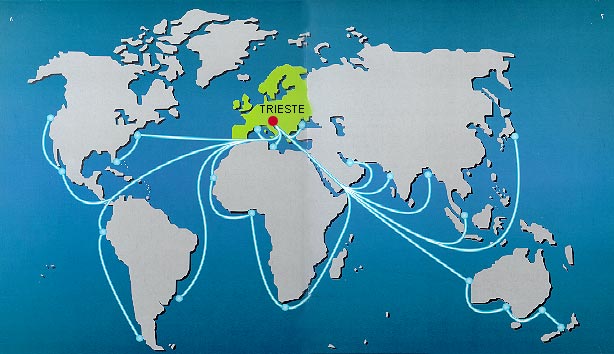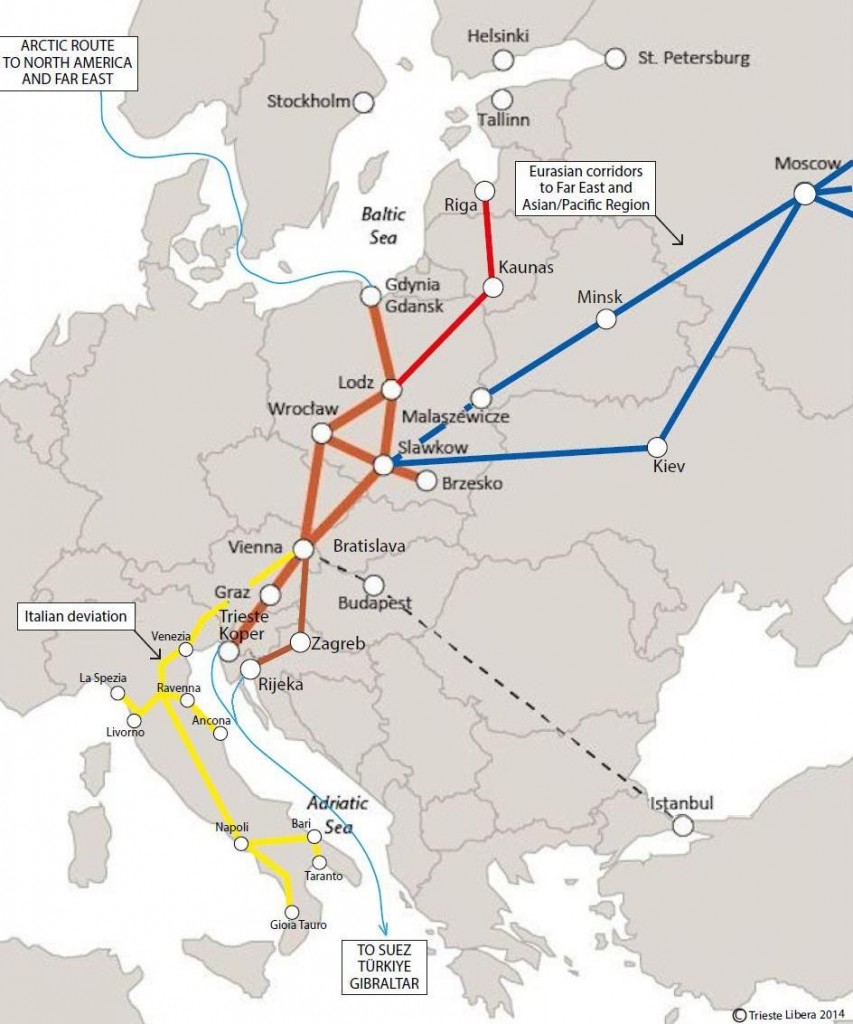Il nuovo Canale di Suez ed i porti adriatici di Trieste, Koper e Rijeka
Analisi di Paolo G. Parovel / Analysis by Paolo G. Parovel
Il 6 agosto 2015 il Governo egiziano ha inaugurato solennemente il raddoppio del canale di Suez – Qanāt al-Suways, chene aumenta da 2 a 4 volte la capacità di traffico con un nuovo bypass di 72 km per consentire la navigazione contemporanea in ambedue le direzioni, e con l’uniformazione dei fondali a 24 metri.
On 6 August 2015 the Government of Egypt has solemnly inaugurated the doubling of the Suez Canal – Qanāt al-Suways, whish increases 2 to 4 times its traffics capacity with a new, 72Km waterway, which allows simultaneous navigation in both directions, and standardizing its depth to 24 meters.
L’impatto strategico è globale, perché il nuovo canale di Suez diventa anche più conveniente di Panama per la rotta New York-Hong Kong, previene la concorrenza dell’ apertura graduale della rotta artica per il Pacifico e dell’aggancio a Vienna-Bratislava dell’asse ferroviario transiberiano per la Cina, e favorisce l’India ed altri Paesi affacciati sull’Oceano Indiano.
Its strategic impact is global, because the new Suez Canal becomes even more convenient than Panama for the New York-Hong Kong route, it prevents the competition of the progressive opening of the Arctic route to the Pacific and the European junction of the Transsiberian railroad axis to China in Vienna-Bratislava, it favors India and the other Countries bordering with the Indian Ocean.
L’Egitto ha realizzato il nuovo canale in meno di un anno, con l’appoggio dell’esercito ed al costo di 9 miliardi di euro finanziato principalmente dalla popolazione egiziana con l’acquisto di partecipazioni. L’investimento dovrebbe ora fruttare utili crescenti con l’ incremento dei traffici e lo sviluppo connesso di nuove attività economiche in regime di Free Zone.
Egypt completed the new Suez Canal in less than one year, with the support of the Army and at the cost of EUR 9 billions, the major part financed by the people of Egypt, who purchased participations. The investment is now expected to bring increasing profits thanks to the new maritime traffics, as well as the consequent development of new economic activities in Free-Zones.
Le vicende del Canale di Suez continuano a condizionare i traffici marittimi internazionali dal 1869, quando li rivoluzionarono consentendo la navigazione diretta tra l’Europa e l’Asia senza circumnavigare l’Africa, con effetti politico-strategici determinanti, nel bene o nel male, per tutto il 20° secolo. e con enormi benefici per i porti ed i commerci europei.
The events of the Suez Canal keep influencing international maritime traffics since 1869, when they revolutionized them allowing direct navigation between Europe and Asia, without circumnavigating Africa, leading to decisive political-strategic effects, for better or worse, through the entire XX century, and with enormous advantages for European ports and trades.
L’apertura di Suez aveva consolidato in particolare il ruolo di Trieste come porto strategico dell’Austria-Ungheria, che aveva partecipato all’opera anche con il progettista Alois-Luigi Negrelli e con il finanziere triestino Pasquale Revoltella, ed aveva poi sottoscritto l’internazionalizzazione del Canale con il Trattato di Costantinopoli del 1888.
In particular, the opening of the Suez Canal had consolidated the role of Trieste as strategic port of Austria-Hungary, which took part to the works also with the contributions of engineer Alois-Luigi Negrelli and Triestine financier Pasquale Revoltella, as well as subscribing the internationalization of the Canal with the Convention of Constantinople of 1888.
Per il suo ruolo strategico consolidato da Suez Trieste, dopo esser stata aggredita ed occupata tra 1918 ed il 1945 dall’Italia e poi dalla Germania, nel 1947 è stata trasformata dalle Nazioni Unite (UNSC Resolution 16/1947, Treaty of Peace 10 Feb. 1947) nel Free Territory of Trieste con Porto Franco internazionale sotto la tutela diretta del Consiglio di Sicurezza, che l’ha affidato dal 1954 all’amministrazione civile provvisoria del Governo italiano.
For its strategic role, consolidated by the Suez Canal, Trieste, after being attacked and occupied from 1918 to 1945 by Italy and then by Germany, was turned by the United Nations (UNSC Resolution 16/1947, Treaty of Peace 10 Feb. 1947) in the Free Territory of Trieste with an International Free Port under direct guarantee of the Security Council, which, in 1954, entrusted it to the responsibility of the Italian Government under a mandate of temporary civil administration.
I Trattati in vigore destinano il Porto Franco internazionale di Trieste al traffico ed alla lavorazione senza tasse né discriminazioni delle merci di tutti gli Stati, e ad essere il porto d’armamento delle flotte commerciali di Svizzera, Austria, Ungheria, Slovacchia e Repubblica Ceca.
The Treaties in force destine the international Free Port of Trieste to the traffic and the manufacturing of the goods of all States without taxes or discriminations, as well as to be the port of register of the commercial fleets of Switzerland, Austria, Hungary, Slovakia and Czech Republic.
Ora il raddoppio del Canale di Suez accresce il ruolo naturale di Trieste (Free Territory), ma anche dei porti vicini di Koper (Slovenia) di Rijeka (Croazia), come terminali di smistamento strategico coordinato dei nuovi traffici fra la rotta di Suez e l’asse Baltico-Adriatico, con forti effetti di stabilizzazione economico-politica del Sudest Europa e dell’area ex-jugoslava.
The doubling of the Suez Canal does now increase the natural role of Trieste (Free Territory), but also that of the neighboring ports of Koper (Slovenia) and Rijeka (Croatia), as strategic center for the distribution of the freight between the route of Suez and the Baltic-Adriatic route, with important effects of political and economic stabilization of South-Eastern Europe and of the area of former Yugoslavia.
L’assenza di una delegazione di Trieste alla storica inaugurazione del raddoppio del Canale di Suez può quindi sembrare sorprendente. Ma rivela tutta la gravità del problema anomalo che paralizza da anni questo piccolo Stato europeo ed il suo Porto Franco internazionale: gli abusi con cui il Governo amministratore civile provvisorio italiano tradisce il mandato delle Nazioni Unite.
The absence of representatives from Trieste to the historic inauguration of the doubling of the Suez Canal might seem quite surprising. But it does at the same time reveal all the gravity of the abnormal problem that paralyses, since years, this little State of Europe and its international Free Port: the abuses with which the provisional Government betrays the mandate of temporary civil administration entrusted to it by the United Nations.
L’amministrazione provvisoria italiana di Trieste, oltre ad essere inetta e profondamente corrotta a livello politico, economico e giudiziario, simula infatti che il Free Territory appartenga allo Stato italiano, ed usa questo inganno per soffocare con prepotenza l’economia locale e per paralizzare il Porto Franco internazionale a favore dei porti italiani (leggete qui le analisi in italiano e inglese: LINK).
Because the provisional Italian administration of Trieste, other than being inept and deeply corrupted on the political, economy, and judiciary levels, does actually simulate that the Free Territory belongs to the Republic of Italy, and it uses this deceit to brutally suffocate local economy and to paralyze the international Free Port to favor Italian ports (here you can read the analysis in Italian and English: LINK ).
Il danno economico creato da questi abusi del Governo amministratore italiano è enorme non solo per il Free Territory of Trieste, ma anche per tutti gli altri Stati che hanno diritti generali e speciali sul Porto Franco internazionale (dagli USA all’India, al Brasile, alla Cina, alla Russia, ecc.), ed ha altre conseguenze strategiche sinora pericolosamente trascurate.
The economic damage caused by the abuses committed by the provisional Italian Government is enormous not only for the Free Territory of Trieste, but also for all the other States holding general and special rights on the international Free Port (from the United States to India, from Brazil to China, but also Russia and many others), and it has strategic consequences that, so far, were dangerously neglected.
Nell’Unione Europea Roma sta infatti tentando di deviare artificialmente i traffici dell’asse Baltico-Adriatico dai porti di Trieste, Koper e Rijeka sui porti della penisola italiana sottraendo risorse economiche essenziali alla stabilizzazione dell’area ex-jugoslava Gli analisti specializzati sanno inoltre che quest’operazione ha radici politiche e criminali complesse.
For instance, in the European Union, Rome is attempting to artificially divert the traffics of the Baltic-Adriatic axis from the ports of Trieste, Koper and Rijeka to the ports of the Italian peninsula, subtracting economic resources that are essential for the stabilization of the area of former Yugoslavia. Also, specialized analysts know that this operation has complex political and criminal roots.
L’inaugurazione del nuovo Canale di Suez dovrebbe perciò attirare l’attenzione strategica internazionale anche sulla necessità di proteggere e riattivare con urgenza le funzioni economiche dell’attuale Free Territory of Trieste, del suo Porto Franco internazionale e dei porti vicini di Koper e di Rijeka per la stabilizzazione del Sud-Est Europa e dei Balcani occidentali.
The inauguration of the new Suez Canal should, therefore, draw international strategic attention also on the need to protect and urgently restore the economic function of the current Free Territory of Trieste, of its international Free Port and of the neighboring ports of Koper and Rijeka, to stabilize both South-Eastern Europe and western Balkans.
Paolo G. Parovel
© 7 Agosto 2015


















